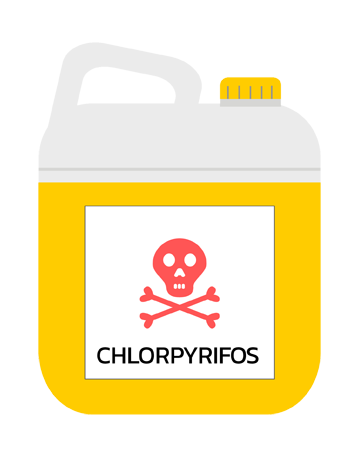Free Case Evaluation
You will never be charged a fee unless a recovery is made for you.
We are no longer accepting new cases.
Trustwell Law is accepting cases from individuals exposed to chlorpyrifos in the womb or at a very young age who have suffered adverse neurodevelopmental, neurobehavioral, and other neurological outcomes—such as attention-deficit/hyperactivity disorder (ADHD) or autism spectrum disorder.
Chlorpyrifos (pronounced chlor·pyr·i·fos (klȯr-ˈpir-ə-fäs)) is a widely used pesticide that kills insects by attacking their nervous systems. Research has shown that humans exposed to chlorpyrifos experience adverse effects, and that very young children, babies, and fetuses (those with still-developing nervous systems) are particularly susceptible to harm.

If you or a loved one were exposed to chlorpyrifos in the womb or at a very young age and now have ADHD, are on the autism spectrum, or have been diagnosed with another severe neurological disorder, you may be entitled to compensation.
If you are considering filing a chlorpyrifos lawsuit, call us at 800-796-1636 or submit your case details online and someone will contact you shortly. You pay nothing unless your lawsuit is successful and you receive compensation.
At Trustwell Law, our experienced attorneys take a personalized, compassionate approach. We cut through the legalese and partner with our clients. We have access to the expertise, resources, and manpower to fully investigate each case and fight for and with our clients to get the justice they deserve.
Chlorpyrifos is a common organophosphate insecticide that works by attacking insects’ nervous systems. It is used to control unwanted insects on plants and in the soil—both invasive pests, such as worms, spiders, weevils, grasshoppers, aphids, and beetles, and public health pests, such as mosquitos and fire ants. It is used on crops, golf courses, industrial plants, and vehicles, and on non-structural wood treatments such as processed wood products, fence posts, and utility poles.
American farmers have been using chlorpyrifos on crops since 1965. It has also been widely used in non-agricultural settings like golf courses. In addition, chlorpyrifos was commonly used in homes and gardens to control pests until the year 2000, when the EPA negotiated an agreement with the manufacturers to stop using it in household products.
Chlorpyrifos has been used to treat fruit and nut trees, row crops, and grains, including:

Some other chlorpyrifos facts and numbers:
People may be exposed to chlorpyrifos by eating it, by inhaling it when it is sprayed, or by skin contact.
Those at highest risk are people living near places where chlorpyrifos is sprayed, working on farms where it is sprayed, or working in packing plants where the chemical is used.
Chlorpyrifos is used on feed crops (crops used to feed livestock), so there may be chlorpyrifos residue in milk, eggs, and meat. Chlorpyrifos residue has been found on citrus fruits and melons even after they have been washed and peeled. Drinking water has been found to contain chlorpyrifos.
People have also been exposed to chlorpyrifos from the drift of the toxic spray.
Children are a greater risk from chlorpyrifos exposure because they often put their fingers or hands in their mouths. Children also eat more fruits and vegetables and drink more water and juice in proportion to their weight. A CDC (Centers for Disease Control and Prevention) study showed that children typically carried almost twice the level of chlorpyrifos in their bodies as compared to adults. A 2014 report from California’s Department of Public Health listed chlorpyrifos in the top 10 pesticides of concern most commonly used within a quarter mile of schools.
In 2016, the U.S. Environmental Protection Agency (EPA) released a revised health assessment for chlorpyrifos. The report basically confirmed that there are no safe uses for chlorpyrifos.
The EPA reported that:
In August 2021, the EPA issued a final rule stating it would no longer allow (or “tolerate”) any chlorpyrifos residue on food and revoked the approved uses for chlorpyrifos in agriculture. The EPA also stated that non-agricultural, non-food uses of chlorpyrifos, such as for mosquito control and in plant nurseries, would be subject to review in 2022.
Several states, including California, Hawaii, and New York, have banned, or are considering banning chlorpyrifos.
Corteva, Inc., formerly Dow Chemical and the largest producer of chlorpyrifos in the United States, announced it will stop selling the chemical in 2021.
Do you want to consult a chlorpyrifos lawyer?
If you or a loved one have been exposed to chlorpyrifos—in utero or as a young child—and have severe neurological injuries, you may be entitled to compensation for:
Contact us for a free consultation. The company(ies) that endangered your health and your brain function without adequate warning or consideration should be held accountable.
End Notes
Earthjustice. (n.d.). Chlorpyrifos. Retrieved from https://earthjustice.org/features/what-you-need-to-know-about-chlorpyrifos
Article Sources
Centers for Disease Control and Prevention. (2017, April 7). Chlorpyrifos Biomonitoring Summary. Retrieved from https://www.cdc.gov/biomonitoring/Chlorpyrifos_BiomonitoringSummary.html
Davenport, C. (2021, August 18). E.P.A. to Block Pesticide Tied to Neurological Harm in Children. Retrieved from https://www.nytimes.com/2021/08/18/climate/pesticides-epa-chlorpyrifos.html
Earthjustice. (n.d.). Chlorpyrifos. Retrieved from https://earthjustice.org/features/what-you-need-to-know-about-chlorpyrifos
Fitzgerald, E. (2021, August 18). EPA to Ban Chlorpyrifos, Finally. Retrieved from https://earthjustice.org/news/press/2021/epa-to-ban-chlorpyrifos-finally
Hu, X. (2018, April 17). The Most Widely Used Pesticide, One Year Later. Retrieved from https://sitn.hms.harvard.edu/flash/2018/widely-used-pesticide-one-year-later/
Kopjar, N., et al. (2018, January 5). Evaluation of chlorpyrifos toxicity through a 28-day study: Cholinesterase activity, oxidative stress responses, parent compound/metabolite levels, and primary DNA damage in blood and brain tissue of adult male Wistar rats. Retrieved from https://pubmed.ncbi.nlm.nih.gov/29108776/
Lerner, S. (2017, February 3). Protect Our Children’s Brains. Retrieved from https://www.nytimes.com/2017/02/03/opinion/sunday/protect-our-childrens-brains.html
Merriam-Webster. (n.d.). Chlorpyrifos. In Merriam-Webster.com dictionary. Retrieved from https://www.merriam-webster.com/dictionary/chlorpyrifos
National Pesticide Information Center. (n.d.). Chlorpyrifos. Retrieved from http://npic.orst.edu/factsheets/archive/chlorptech.html
Pesticide Action Network. (n.d.). Chlorpyrifos. Retrieved from https://www.panna.org/resources/chlorpyrifos-facts
Pope, C., S. Karanth, and J. Lui. (2005, May). Pharmacology and toxicology of cholinesterase inhibitors: uses and misuses of a common mechanism of action. Retrieved from https://pubmed.ncbi.nlm.nih.gov/21783509/
Romo, V. (2021, August 18). EPA Will Ban A Farming Pesticide Linked To Health Problems In Children. Retrieved from https://www.npr.org/2021/08/18/1029144997/epa-will-ban-a-farming-pesticide-linked-to-health-problems-in-children
Shelton, J., et al. (2014, October 1). Neurodevelopmental Disorders and Prenatal Residential Proximity to Agricultural Pesticides: The CHARGE Study. Retrieved from https://ehp.niehs.nih.gov/doi/10.1289/ehp.1307044
U.S. Environmental Protection Agency. (n.d.). Chlorpyrifos. Retrieved from https://www.epa.gov/ingredients-used-pesticide-products/chlorpyrifos
U.S. Environmental Protection Agency. (2021, August 18). EPA Takes Action to Address Risk from Chlorpyrifos and Protect Children’s Health. Retrieved from https://www.epa.gov/newsreleases/epa-takes-action-address-risk-chlorpyrifos-and-protect-childrens-health
U.S. Environmental Protection Agency. (2016, November). Revised Human Health Risk Assessment on Chlorpyrifos. Retrieved from https://www.epa.gov/ingredients-used-pesticide-products/revised-human-health-risk-assessment-chlorpyrifos
U.S. Environmental Protection Agency. (2021, August 29). Tolerance Revocations: Chlorpyrifos. Retrieved from https://www.regulations.gov/document/EPA-HQ-OPP-2021-0523-0001
You will never be charged a fee unless a recovery is made for you.